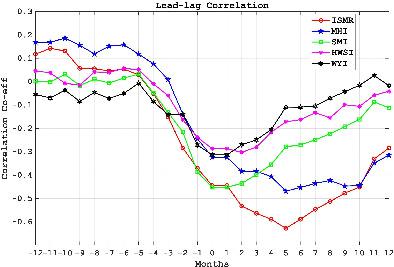当前位置:
X-MOL 学术
›
Q. J. R. Meteorol. Soc.
›
论文详情
Our official English website, www.x-mol.net, welcomes your
feedback! (Note: you will need to create a separate account there.)
Why Indian summer monsoon circulation indices? Fidelity in representing rainfall variability and teleconnections
Quarterly Journal of the Royal Meteorological Society ( IF 3.0 ) Pub Date : 2021-01-02 , DOI: 10.1002/qj.3972 Yasmin Zahan 1 , P. V. Rajesh 1 , B. Abida Choudhury 1 , B. N. Goswami 1
Quarterly Journal of the Royal Meteorological Society ( IF 3.0 ) Pub Date : 2021-01-02 , DOI: 10.1002/qj.3972 Yasmin Zahan 1 , P. V. Rajesh 1 , B. Abida Choudhury 1 , B. N. Goswami 1
Affiliation

|
With the recognition that the circulation is strongly coupled with the Indian summer monsoon rainfall (ISMR), a number of large‐scale circulation indices have been proposed to represent the Indian summer monsoon to aid diagnosis of teleconnections with ISMR and evaluation of simulations by climate models. The circulation indices, however, correlate poorly with ISMR raising doubts on the coupling between the two. In this study, we identify reasons behind the poor correlations and estimate a potential limit on this correlation between circulation indices and ISMR. One mechanistic reason for poor correlations between circulation indices and ISMR is that the period and variance explained by the oscillatory modes of circulation indices differ significantly from those of ISMR leading to their phases also differing between modes of circulation indices and corresponding modes of ISMR. Further, the wind anomaly patterns associated with wind indices project strongly on the climatological monsoon circulation unlike that associated with the ISMR, another reason for their poor correlation with ISMR. As a result, all circulation indices underestimate the negative correlation between June–September sea‐surface temperature (JJAS SST) over the Niño3.4 and ISMR and fail to simulate the lead–lag relationship between the two. A conservative estimate of the interannual variance explained by coupling of the JJAS rainfall over continental India and winds in the neighbourhood is strong, explaining about 55% variance distributed in three leading coupled modes. Therefore, the effectiveness of any circulation indices in explaining the ISMR variance is potentially limited to that associated with the dominant mode (∼30%). The local response of winds to deep convection over the waters of the Indian Ocean and western Pacific warm pool leads to a strong increasing trend in some of the circulation indices and adds “noise” modes contributing to the de‐correlation between circulation indices and ISMR.
中文翻译:

为什么要选择印度夏季风环流指数?代表降雨变化和远程连接的保真度
认识到环流与印度夏季风降水(ISMR)密切相关,已提出了许多大型环流指数来代表印度夏季风,以帮助诊断与ISMR的遥相关并通过气候模型评估模拟。然而,环流指数与ISMR的相关性很差,这引起了两者之间耦合的怀疑。在这项研究中,我们确定了相关性差的原因,并估计了流通指数和ISMR之间这种相关性的潜在极限。流通指数与ISMR之间相关性差的一个机械原因是,流通指数的振荡模式所解释的周期和方差与ISMR的周期和方差显着不同,导致它们的相位在流通指数的模式和ISMR的相应模式之间也不同。此外,与风指数相关的风异常模式在气候季风环流上强烈投影,这与与ISMR相关的异常不同,这是它们与ISMR相关性较差的另一个原因。结果,所有环流指数都低估了Niño3.4和ISMR上6月至9月海表温度(JJAS SST)之间的负相关性,并且无法模拟两者之间的超前-滞后关系。通过印度洋上空的JJAS降雨与附近风的耦合来解释年际方差的保守估计是很强的,这解释了在三种主导耦合模式下大约55%的方差分布。因此,任何循环指数在解释ISMR方差方面的有效性都可能受限于与主导模式相关的有效性(〜30%)。风对印度洋和西太平洋暖池水域深对流的局部响应导致某些环流指数呈强劲增长趋势,并增加了“噪声”模式,从而导致环流指数与ISMR之间不相关。任何流通指标在解释ISMR方差方面的有效性可能仅限于与主导模式相关的有效性(约30%)。风对印度洋和西太平洋暖池水域深对流的局部响应导致某些环流指数呈强劲增长趋势,并增加了“噪声”模式,从而导致环流指数与ISMR之间不相关。任何流通指标在解释ISMR方差方面的有效性可能仅限于与优势模式相关的有效性(约30%)。风对印度洋和西太平洋暖池水域深对流的局部响应导致某些环流指数的强劲增长趋势,并增加了“噪声”模式,从而导致环流指数与ISMR之间不相关。
更新日期:2021-03-07
中文翻译:

为什么要选择印度夏季风环流指数?代表降雨变化和远程连接的保真度
认识到环流与印度夏季风降水(ISMR)密切相关,已提出了许多大型环流指数来代表印度夏季风,以帮助诊断与ISMR的遥相关并通过气候模型评估模拟。然而,环流指数与ISMR的相关性很差,这引起了两者之间耦合的怀疑。在这项研究中,我们确定了相关性差的原因,并估计了流通指数和ISMR之间这种相关性的潜在极限。流通指数与ISMR之间相关性差的一个机械原因是,流通指数的振荡模式所解释的周期和方差与ISMR的周期和方差显着不同,导致它们的相位在流通指数的模式和ISMR的相应模式之间也不同。此外,与风指数相关的风异常模式在气候季风环流上强烈投影,这与与ISMR相关的异常不同,这是它们与ISMR相关性较差的另一个原因。结果,所有环流指数都低估了Niño3.4和ISMR上6月至9月海表温度(JJAS SST)之间的负相关性,并且无法模拟两者之间的超前-滞后关系。通过印度洋上空的JJAS降雨与附近风的耦合来解释年际方差的保守估计是很强的,这解释了在三种主导耦合模式下大约55%的方差分布。因此,任何循环指数在解释ISMR方差方面的有效性都可能受限于与主导模式相关的有效性(〜30%)。风对印度洋和西太平洋暖池水域深对流的局部响应导致某些环流指数呈强劲增长趋势,并增加了“噪声”模式,从而导致环流指数与ISMR之间不相关。任何流通指标在解释ISMR方差方面的有效性可能仅限于与主导模式相关的有效性(约30%)。风对印度洋和西太平洋暖池水域深对流的局部响应导致某些环流指数呈强劲增长趋势,并增加了“噪声”模式,从而导致环流指数与ISMR之间不相关。任何流通指标在解释ISMR方差方面的有效性可能仅限于与优势模式相关的有效性(约30%)。风对印度洋和西太平洋暖池水域深对流的局部响应导致某些环流指数的强劲增长趋势,并增加了“噪声”模式,从而导致环流指数与ISMR之间不相关。











































 京公网安备 11010802027423号
京公网安备 11010802027423号